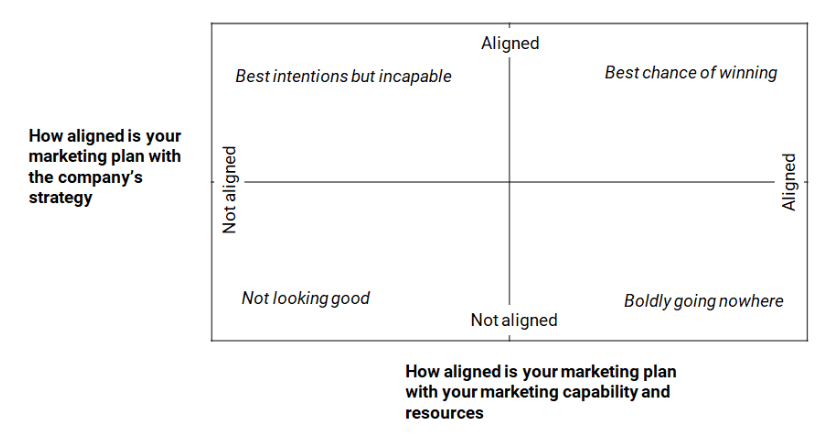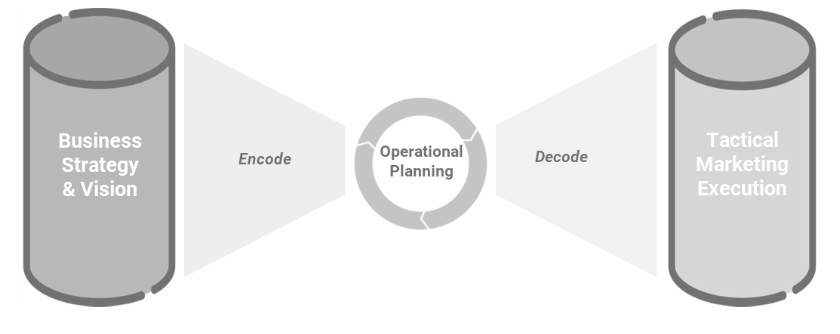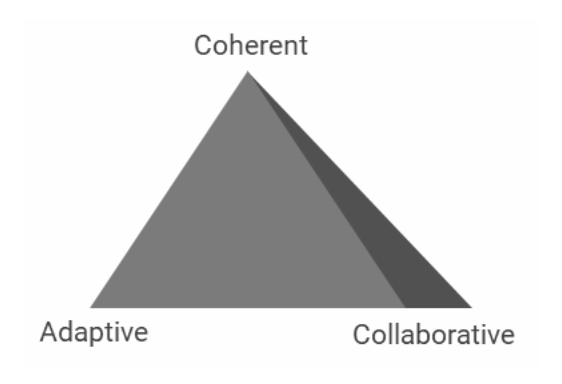This article explores critical factors impacting marketing dissatisfaction, offering a holistic marketing organizational approach to align marketing efforts with business objectives and adapt effectively to market changes.
Anyone lucky enough to manage a marketing function or be responsible for a marketing budget would confirm the marketing landscape is facing several challenges causing disruption and requiring a new approach to marketing management.
The traditional boundaries between marketing practice and other customer-facing functions have become less clear, and the operational complexity is increasing making it crucial for the marketing industry to adapt to these new realities.
As if things weren't complicated enough, such rapid changes are landing on a landscape where it's clear from numerous studies and publications that dissatisfaction with marketing efforts is widespread among business leaders. A notable example is a study published by the Harvard Business Review, revealing that 80% of CEOs are not satisfied with the performance of their Chief Marketing Officers (CMOs), citing a lack of trust.
The widespread discontent among business leaders is attributable to a multiplicity of factors. Chief Marketing Officers (CMOs) face immense pressure to achieve tangible and measurable results in the dynamic marketing landscape. At the same time, many business leadership teams grapple with the challenge of integrating marketing seamlessly into their organizational structure, often leaving marketing operating in a way that is disconnected from the rest of the organization.
Unveiling the Factors Contributing to Business Discontent with Marketing
Frequently cited reasons for the general dissatisfaction with marketing among CEO and business leaders include various crucial issues. Among these, a recurrent concern is the lack of quantifiable outcomes, where marketing endeavors struggle to deliver concrete, measurable results demonstrating a clear return on investment.
Misalignment with organizational objectives also ranks high on the list of discontents. Marketing campaigns are frequently said to need to be more closely aligned with broader business goals, leading to frustration among stakeholders.
In addition, inadequate cross-functional collaboration with other business functions often obstructs the successful execution of marketing plans. Poor interdepartmental communication and a lack of transparency contribute to the dissatisfaction experienced by businesses.
Another significant cause of dissatisfaction revolves around the failure of marketing teams to grasp the intricacies and specificity of their respective industries, resulting in messaging and strategies that fall short of resonating with target audiences.
Insufficient adaptation to ever-changing market dynamics leaves businesses yearning for more agile and responsive marketing efforts that can better address evolving customer preferences and market trends.
Finally, a need for clarity on scope and competencies in marketing organizations. When responsibilities are not clearly assigned among stakeholders, it can cause misunderstandings and result in duplicated efforts.
A Holistic View of Marketing Organizational Planning
Alignment between business vision and marketing execution spans the entire marketing organization, from planning to resourcing, project management and results analysis.
The diagram below adapted from Jonathan Trevor and Barry Varcoe’s alignment test, provides a simple way to evaluate how a marketing plan is aligned with a company's strategy and assess the potential risks and pitfalls.

Strategic marketing alignment diagram. Giovannoni, E. (2023). Modern Marketing Architecture: The Official FAPI Marketing Framework Guidebook. Chasefive.
The alignment diagram emphasizes two clear keystones of marketing success. Firstly, the company's tactical marketing plan and business plan must be integrated. Secondly, the marketing resources and capability must align with the marketing plan.
An early-stage litmus test for business leaders to determine if their business and marketing organization needs better integration is whether they frequently ponder the next big marketing idea during their morning commute to the office. Even worse, they may question why they are executing all the right marketing activities, yet things don't seem to gel.
Uncomfortable Truth About Aligning Business Vision & Marketing Planning
Many business leaders tend to tackle marketing reactively, but the battle for alignment between business direction and marketing execution is won or lost in the planning stage.
A modern marketing organizational plan needs to be collaborative and coherent and involve the entire leadership team, starting with ‘encoding’ the business vision and objectives in the marketing plans. The business leadership team needs to take responsibility for leading the process.
The strategy encoding process is a core responsibility of the business leadership team working closely with the CMO (Chief Marketing Office), who needs to clearly understand the strategic vision set in place by the business and ensure it is reflected in the tactical marketing plans.
A classic example of how frequently the process of encoding the strategy is overlooked or misunderstood is the common practice by businesses of all sizes to dive into marketing production as soon as budgets are approved without first crystallizing the marketing plans.

Encoding business vision into marketing plans. Giovannoni, E. (2023). Modern Marketing Architecture: The Official FAPI Marketing Framework Guidebook. Chasefive.
How to Address Misalignment Between Vision & Execution
To translate business strategy into successful marketing plans effectively, it's crucial to have a comprehensive end-to-end approach to marketing organization and planning.
The process needs to be centered around critical tenets that serve as the foundation for alignment and collaboration and can be summarized as follows.
1. Integration
Integrate all functional leads into the planning process.
It is crucial to involve all key stakeholders in the marketing planning process, including managers from sales, product development, customer service, and other relevant departments. Encouraging open communication, resource sharing and exchanging ideas will lead to developing a more cohesive and unified strategy.
2. Tactical Marketing Models
Adopt a tactical marketing model fit for the business model.
In today's rapidly changing business environment, technology adoption and disruptive business norms have made it difficult to distinguish between different traditional tactical marketing models.
Simply relying on standard structures like B2B, B2C, or D2C may not lead to the best alignment between marketing implementation and business goals.
The lines between tactical marketing models can be better defined by identifying certain target audience characteristics, such as transaction velocity and end-user data ownership, as key parameters to guide tactical execution.
3. Preparation
Only begin production once the bill of materials is ready.
Starting marketing production without a complete bill of materials can cause significant deviations from the business vision. To minimize this risk, it's important to follow a structured approach, making sure all parameters for execution are clearly defined, including all required resources (media, labor, and tools), performance indicators, and outcome projections.
4. Clarity
Allocate clear responsibilities and scope of work.
Poorly defined responsibility allocation during execution can significantly impact production workflows, causing confusion and inefficiencies.
When roles and responsibilities are unclear, team members may find it challenging to understand their specific tasks and contributions to the overall marketing plan. This lack of clarity can lead to inconsistent flows resulting in a fragmented scenario and risking the loss of direction.
5. System Thinking
Interpret insights holistically.
The main aim of marketing data analysis is to predict and control outcomes. However, the complex nature of marketing requires us to understand analytical insights as a whole, focusing on relationships and understanding correlations rather than breaking marketing activities down into individual isolated parts.
Anyone working in marketing would easily recognize real-life scenarios for most of the points listed above. The challenge of addressing these issues, even in a small organization, cannot be overstated, as it demands both strong leadership skills and technical know-how.
Yet, this is the expectation for today's modern marketing management, who must be astute marketing strategists, competent project managers, and technically savvy specialists.

Modern marketing organizational framework. Coherent, Collaborative, Adaptive. Giovannoni, E. (2023). Modern Marketing Architecture: The Official FAPI Marketing Framework Guidebook. Chasefive.
Place Your Marketing Team in a Position to Excel
Developing a robust end-to-end marketing planning and organizational framework is, above all, about placing marketing production teams in the best position to do what they do best: creating amazing marketing activities that can yield results.
Implementing a comprehensive marketing planning and organizational framework is in fact, a strategic investment. A strong marketing structure empowers production teams with the necessary resources, direction, and focus to unleash their creativity and innovation. This allows them to concentrate on creating compelling campaigns that truly resonate with the target audience.
The systematic process of building a robust tactical marketing blueprint by encoding the strategic business vision into tactical marketing production leads to improved outcomes, heightened efficiency, and maximized return on investment (ROI.
Additional Reading: